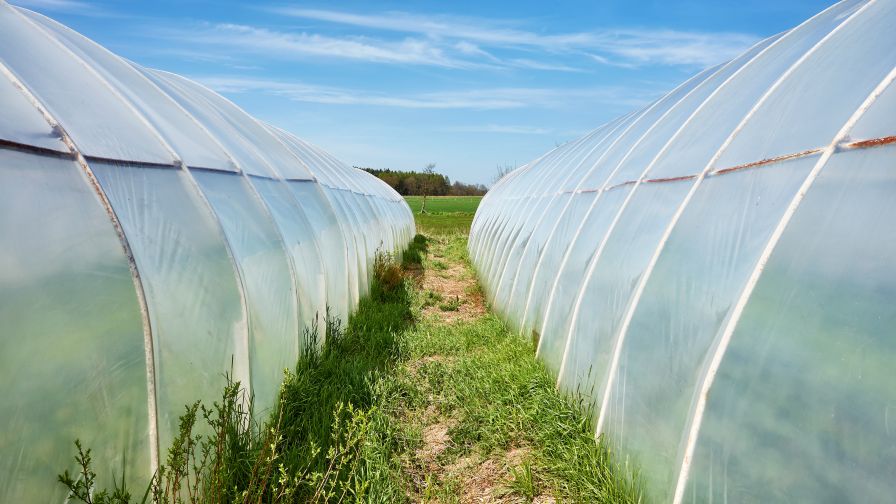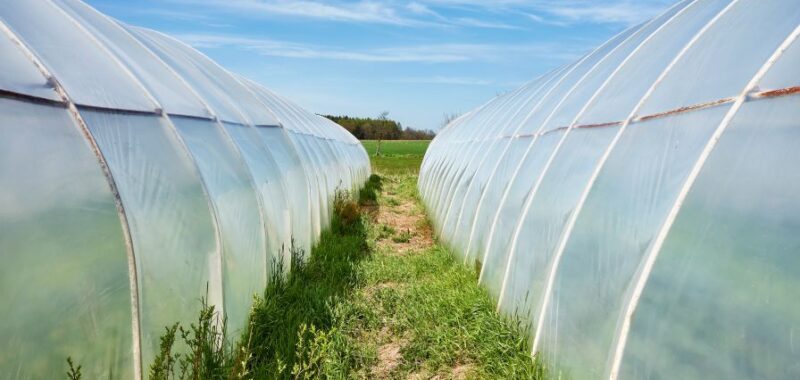
Polyethylene film “Polytunnel” hoop greenhouses | Maciej Bledowski
If you’re running a greenhouse covered by polyethylene film, then you know that a replacement job is probably coming up in the next few years. The integrity of your poly roof is critical to the success of your crops, your plugs, or your trees – whatever your business is growing.
Despite its significance, the maintenance and replacement of poly roofs can often be kicked down the road until visible deterioration occurs. It’s not that poly is overlooked, per se, but as a going concern on the business’s budget, yes, poly can sometimes land on the back burner.
We’re here to demonstrate why that’s not such a good idea. Get out in front of your poly replacement needs, and season after season you’ll find greater efficiencies in the greenhouse.
When to Replace Your Greenhouse’s Poly Roof
Alan Barnitz, Assistant Manager of the Plug Division at Bob’s Market and Greenhouses in West Virginia, took over the responsibility for the greenhouse coverings in the family-run business. He knows the importance of timely poly roof replacement.
Typically, teams will replace poly every four years, maybe every three years if the material is looking dicey. Barnitz says the Bob’s team staggers this replacement work across their dozen or so structures; it’s a major investment of time and money, after all.
“We used to change all of our poly in-house, and it just got harder and harder to find the folks who are willing to get up and get on top of a greenhouse, because that’s a challenging job,” he says.
It’s perhaps made more challenging–or at least more consequential–because Bob’s is located close to a coal-fired power plant. This places a premium on that four-year mark for replacements; the soot in the region can degrade the poly material faster than in other environments.
“We’ve observed that not replacing the poly on time leads to not just reduced light transmission, which is crucial for plant growth, but also increased energy costs due to poor insulation,” he says.
Technical Insights to Consider
Amy Lynch, Strategic Business Manager at Berry Global, says that most greenhouse polyethylene is UV-stabilized and warrantied for four years, which is where the typical replacement cadence comes from. However, this does not mean all poly roofs can last that long under every condition.
Chemical exposure and geography can affect the performance. “Operators in the north might see a longer lifespan due to less intense sun exposure compared to their southern counterparts,” she says.
Still, that four-year benchmark is very helpful; just because the film physically hasn’t failed after four years does not mean operators are getting the most optimal growing environment out of it. Lynch says she visited a grower in the South, and the team was throwing away plants because they were getting too much stretch. On closer inspection, the poly film had been manufactured 12 years ago.
Time and Money Concerns for Roof Replacement
Increasingly, operators are looking at poly roof maintenance with different budgetary eyes. “What used to be a regular maintenance expense has now often been categorized as a capital expenditure, reflecting the significant upfront costs associated with poly replacement.”
Those costs typically come up in vendor transactions in the spring. Get out in front of the expenditures for the year and place your orders for timely delivery in later seasons. Most greenhouse operators will plan to do the actual replacement work in the fall.
“If you put poly on when it’s too hot, it will stretch and lay out really, really nice,” Barnitz says. “But the only downfall is when winter comes, it contracts and pulls really hard on your entire structure. [That contraction] makes it more difficult for vents to close. It’ll pull little gaps on your vent brackets, and then you have heat loss.” Autumn provides a good balance when temperatures are around 70°F.
The Bubble Problem of Poly Film Coverings
It’s important to regularly inspect and replace any old or deteriorated hoses from the blower to the plastic hookup. At Bob’s, the maintenance team consistently monitors the blower tubes to ensure the bubble remains inflated. This prevents the wind from pulling the poly sheet out from under the spring wire.
Proper inflation not only enhances insulation but also ensures the spring wire tightens securely against the poly, maintaining the structural integrity of the greenhouse cover.
The exterior layer of a poly greenhouse serves as the primary defense against environmental elements like wind and hail. This outer barrier is essential for protecting the greenhouse structure.
In setups such as high tunnels or overwinter poly houses, where only a single sheet of plastic is used, the material is prone to billowing under windy conditions. This repeated movement can cause the plastic to continuously strike the structural supports or purlins, leading to wear and potential degradation of the film’s integrity. Hence another benefit of the bubble.
To enhance structural stability and prolong the lifespan of the greenhouse covering, a double-layer configuration is highly advantageous.
The Investment of an Updated New Greenhouse Roof
Effective management of your poly film is an important maintenance routine and a strategic endeavor that significantly impacts the health and productivity of your plants.
Missing the mark on poly replacement has provided hard-won lessons for greenhouse operators across the industry. The main lesson: Don’t let budget constraints delay necessary updates that can prevent larger issues such as increased heating costs, poor crop quality, and structural damages due to environmental stresses.
Poly roof replacements, ideally conducted every four years, should align with the specific environmental challenges and operational demands of each greenhouse. Operators should consider the severity of local conditions — like proximity to industrial zones or high UV exposure areas — which can accelerate the aging process of poly roofs. Planning replacements in the fall, when temperatures are moderate, ensures the material integrity during installation, avoiding the pitfalls of contraction in colder weather.
Ultimately, maintaining the structural integrity and functionality of your greenhouse through timely poly roof replacements is an investment in your business’s future. It safeguards against operational inefficiencies and supports optimal plant growth environments, thereby enhancing overall productivity and profitability.
For additional information and details on the benefits and upkeep of poly roof films for greenhouses, please read the original article found on the LLK Greenhouse Solutions website.

